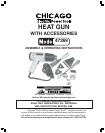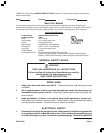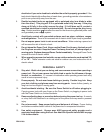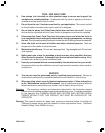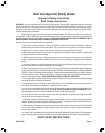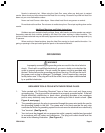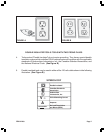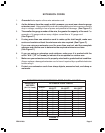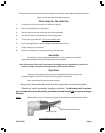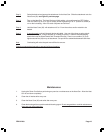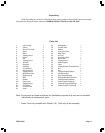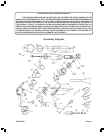
ITEM 47269 Page 5
Heat Gun Specific Safety Rules
Important Safety Instructions
Read These Instructions
WARNING: Extreme care should be taken when stripping paint. The peelings, residue and vapors of paint may
contain lead, which is poisonous. Any pre-1977 paint may contain lead and paint applied to homes prior to 1950 is
likely to contain lead. Once deposited on surfaces, hand to mouth contact can result in the ingestion of lead.
Exposure to even low levels of lead can cause irreversible brain and nervous system damage; young and unborn
children are particularly vulnerable.
Before beginning any paint removal process you should determine whether the paint you are removing
contains lead. This can be done by your local health department or by a professional who uses a paint analyzer to
check the lead content of the paint to be removed. LEAD-BASED PAINT SHOULD ONLY BE REMOVED BY A
PROFESSIONAL AND SHOULD NOT BE REMOVED USING A HEAT GUN.
Persons removing paint should follow these guidelines:
1) Move the work piece outdoors. If this is not possible, keep the work area well ventilated. Open the
windows and put an exhaust fan in one of them. Be sure the fan is moving the air from inside to outside.
2) Remove or cover any carpets, rugs, furniture, clothing, cooking utensils, and air ducts.
3) Place drop cloth in the work area to catch any paint chips or peelings. Wear protective clothing such
as extra work shirts, overalls, and hats.
4) Work in one room at a time. Furnishings should be removed or placed in the center of the room and
covered. Work areas should be sealed off from the rest of the dwelling by sealing doorways with drop
cloths.
5) Children, pregnant or potentially pregnant women, and nursing mothers should not be present in the
work area until the work is done and all clean up is complete.
6) Wear a dust respirator mask or a dual filter (dust and fume) respirator mask which has been approved
by the Occupational Safety and Health Administration (OSHA), the National Institute of Safety and Health
(NIOSH), or the United States Bureau of Mines. These masks and replaceable filters are readily available
at major hardware stores. Be sure the mask fits. Beards and facial hair may keep masks from sealing
properly. Change filters often. DISPOSABLE PAPER MASKS ARE NOT ADEQUATE.
7) Use caution when operating the Heat Gun. Keep the Heat Gun moving as excessive heat will generate
fumes which can be inhaled by the operator.
8) Keep food and drink out of the work area. Wash hands, arms, and face and rinse mouth before eating
or drinking. Do not smoke or chew gum or tobacco in the work area.
9) Clean up all removed paint and dust by wet mopping the floors. Use a wet cloth to clean all walls, sills,
and any other surface where paint or dust is clinging. DO NOT SWEEP, DRY DUST OR VACUUM. Use a
high phosphate detergent or trisodium phosphate (TSP) to wash and mop areas.
10) At the end of each work session put the paint chips and debris in a double plastic bag, close it with
tape or twist ties, and dispose of properly.
11) Remove protective clothing and work shoes in the work area to avoid carrying dust into the rest of the
dwelling. Wash work clothes separately. Wipe shoes off with a wet rag that is then washed with the work
clothes. Wash hair and body thoroughly with soap and water.
12) Take caution as some woods contain preservatives such as copper chromium arsenate (CCA) which
can be toxic. When working with these materials extra care should be taken to avoid inhalation and
minimize skin contact.
13) People with pacemakers should consult their physician(s) before using this product. Electromagnetic
fields in close proximity to a heart pacemaker could cause interference to or failure of the pacemaker.
SAVE THESE INSTRUCTIONS.



